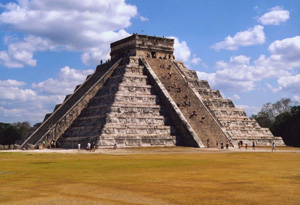 |
At first I would like to
explain how the pyramid is laid out. The pyramid is 30m high. 24m for
the main pyramid, 6m for the temple on top of the pyramid. The base of
the pyramid is 55.3m at each side. Each of the 4 sides of the pyramid
features 91 steps to the top. 91x4=364 + 1 step on top for the temple =
365 steps. Exactly the days in a calendar year. This feature by itself
would be a great achievement from the builders that already shows great
astronomical knowledge. But this building holds more surprises that are
even more incredible.
|
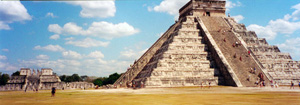 |
This panorama image taken in
2000 shows the Pyramid of Kukulkan (El Castillo) and the Warrior Temple
behind it. |
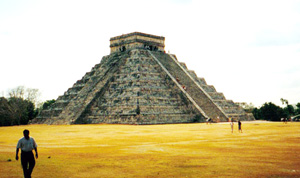 |
Only two of the four sides of
the pyramid are completely restored. The other two sides are left
unrestored. This shows nicely waht state the pyramid was before the
1920s. The photo on the left and one below show those unrestored sides
that are not photographed very often..
|
|
|
A closer look at the unrestored
part of the pyramid. |
|
|
A side effect of all the
astronomical features expained below is that the steps are
extraordinarily steep. |
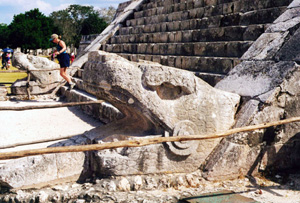 |
At the bottom of the stairway
you will find two snake heads. Please read on to find out why they are
there. You have to note that the snake heads are only on one side of
the pyramid. |
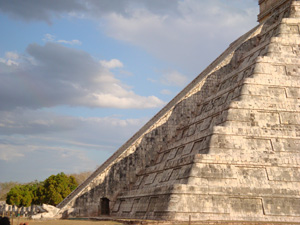
Image Source: Wikipedia Commons
|
Every year on the spring and autumn equinoxes a
spectacle is visible that draws hundreds of visitors to the site. On
those two days the sun illuminates the pyramid in a way that the sun
and shadow of the pyramid's steps draw the image of a snake on it's
stairway. The snake head shown on the photo above is the actual head of
the snake illusion made out of light and shadow. (see photo to the left)
As the sun rises the optical illusion makes it look like the snake of
light and shadow crawls down the pyramid just like the legend of
Kukulkan says.
During the Autumn equinox the spectacle is reversed and it looks like
the snake crawls up the pyramid to the sky. I'm currently working on a
3D computer simulation of the effect, but I'm not a wiz with 3D
programs. Please be patient and check back.
|
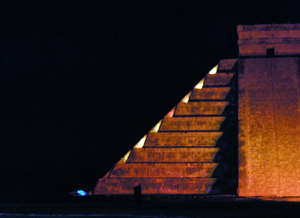 |
If you want to see a simulation of the effect in
person and you can't make it during the equinoxes, I recommend visiting
the after hours light show. Here the effect is made visible with
spotlights. |
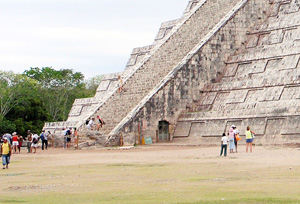 |
Along with the restauration of the pyramid in the
1930s excavations took place. During those excavations it was
discovered that the Pyramid as we see it today was built over an older
pyramid. This is not unusual for Mayan buildings. The unusual part was
that a tunnel leading to an intact staircase inside the pyramid was
found. Those stairs lead to an intact room that was once the top of the
older pyramid. The Mayan architects designed the newer pyramid
specifically so this staircase and room from the older pyramid stayed
intact, without being accessable. One could get the impression that
they wanted to preserve a secret or message of some kind from their
ancestors.
The photo on the left shows the entrance to the hidden starcase that
was carved out in the 1930s. Back in 2005 when this photo was taken it
was still possible to enter the hidden passage and the room on top
every hour or so. Now this area is closed to the public, unfortunately.
The staircase and the room are extremely dark and flash photography was
not allowed. |
|
|
The staircase and the room are extremely dark and
flash photography was not allowed. My photography equipment at the time
was not as suited for low light photography as it is today, so the
images are not as crisp as they should be. But they still show the
important things.
On the left you see the inside of the pyramid with it's hidden
staircase. The stairs are basically the outside stairs of the older
pyramid left intact by the builders of the current pyramid. The stairs
are extremely steep. Inside the hallway are steamy temperatures. My
handheld thermometer registered 48 degrees Celsius. The humidy was very
high and you arrive at the top trenched in your own sweat. "I'm sorry
to drip on you" another guy said to me :). |
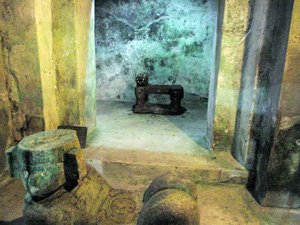 |
After 15 to 20 meters climbing up, you stand on top
of the old pyramid. Now this is only a relatively small room. The
biggest attraction is the "Jaguar Idol" you see in the back. It's a
carved figurine resembling the animal. It's eyes are made from white
colored stones which give the idol kind of an eerie look. In front of
the room is a typical Mayan statue of Chac mool. Most people stoped
here took a photo and left to get out of the smeltering heat. But the
most interesting thing here you will find if you look up... |
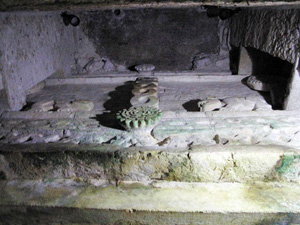 |
Here in almost complete darkness you can only
vaguely make out that there are carvings on top of the room with the
Jaguar. What looks well lit here in the photo is due to the fact that I
made a 2 second exposure with the camera with it's aperture wide open.
With this exposure setting the camera can see more then the naked eye.
Please note that I have not found any other photograph of this carving
anywhere on the internet. Nobody seems to notice this important carving.
Now we can see two Jaguar carvings, both facing inwards to a tall
carving in the middle. I would like to point your attention to the
carving in the middle. Closest to the camera is a round object which
looks a bit like a flower. The carving on top of this object is what I
think is sensational. Let's look at this a bit closer. |
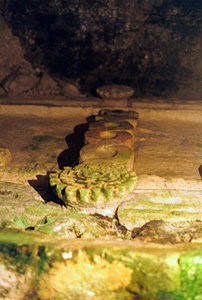
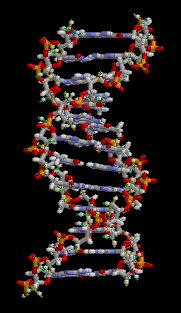 Image source: Wikipedia commons
Image source: Wikipedia commons |
The photo on the left I took 5 years earlier with a
film camera. It turned out quite well. The different colors are the
result of the faint source of light that illuminated the scene. I guess
the lightbulb must have changed in 5 years :)
But on to the carving: You can clearly see that above the flower like
carving is something like two figure 8 on top of each other. This
symbol is the central symbol of the old pyramid as the two Jaguar
figures on each side are telling us.
I visited many other ruins and pyramids in Mexico, I have never come
across a similar carving. If you have,
please let me know, I would be very interested to find out more.
The reason I find this carving so
sensational is because I think it shows us a symbolized model of the
DNA double helix that is the basic building block of every living
being! Here a modern depiction of a DNA double Helix:
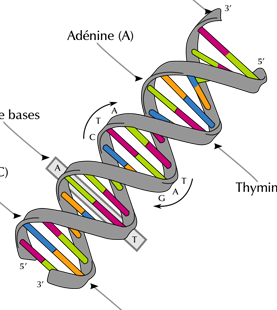
Image source: Wikipedia commons
In my opinion the blooming
flower underneath (and above if you look closely) the DNA symbolizes
life, which is a great way to describe it.
|
| |
|

